Do you want to learn some hermit crab facts for kids? They are included in this post. We’ll talk about hermit crabs’ physical descriptions, shells, offspring, and more!
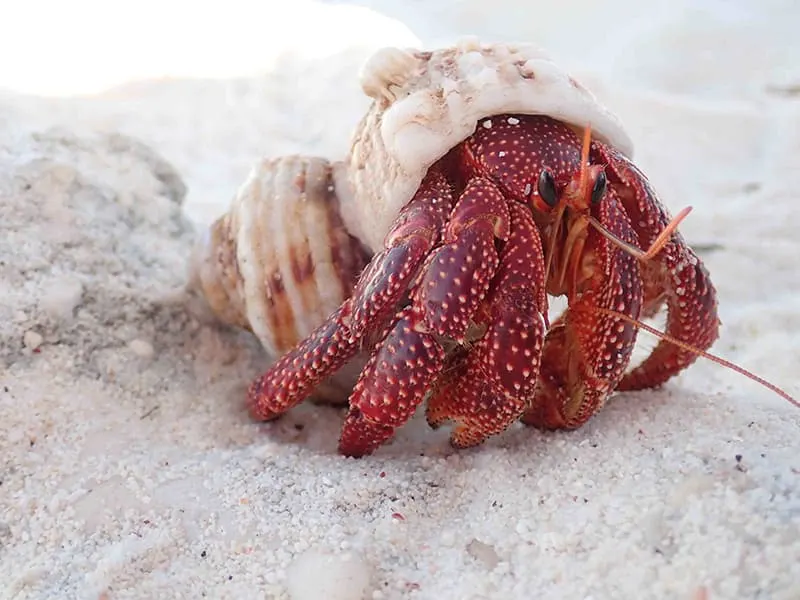
There are more than 1,100 species of hermit crabs. These are divided into two categories: One category is the aquatic (water-dwelling) hermit crab. The other is the terrestrial (land-dwelling) hermit crab. Most hermit crab species are aquatic. There are more than 1000 species of aquatic hermit crab. There are only about 15 species of terrestrial crab.
Here are some notable differences between aquatic crabs (also known as marine crabs) and terrestrial hermit crabs:
- The legs of terrestrial crabs are solid colored with no markings. The legs of marine crabs have markings.
- Algae and barnacles are common on the shells of aquatic hermit crabs. Terrestrial hermit crabs don’t typically have these.
- Terrestrial hermit crabs live on the shoreline near water. Marine hermit crabs live in the water and do not venture onto land.
- Hermit crabs sold in pet shops are typically terrestrial hermit crabs.
- Both types of hermit crabs have gills. In water, however, terrestrial hermit crabs are unable to breathe. On land, aquatic hermit crabs can only breathe for a short time.
Learn more about the terrestrial hermit crab in this article.
Except for one freshwater species, all aquatic hermit crabs live in saltwater.
In this article, we will be talking about marine hermit crabs that live in salt water.
Physical Description
The hermit crab has ten jointed legs. These legs are multicolored with markings. The front legs are two different sizes. The hermit crab’s larger left front leg has a claw that the crab uses to defend itself. The hermit crab’s smaller right front leg has a claw that the crab uses to scoop food and water. The other legs do not have claws because they are walking legs. A hermit crab’s hind legs are smaller than its other legs.
The hermit crab has two compound eyes attached to eye-stalks. There are four antennae attached to its head. Two of the antennae are straight and long. The other two antennae are curled and shorter.
Hermit crab bodies can be a variety of colors. These colors include green, red, blue, yellow, orange, brown, pink, and white. The majority of marine hermit crabs range in size from one and a half inches to four inches.
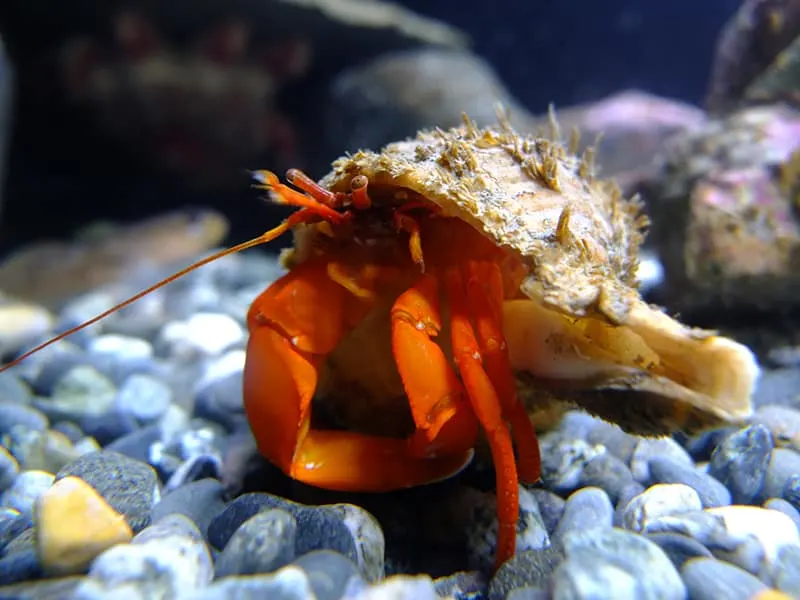
Exoskeleton
The body of a hermit crab is shaped like that of a crayfish. The covering on a hermit crab's body is called an exoskeleton. The hermit crab has a hard exoskeleton that does not cover its abdomen. To protect its abdomen, the hermit crab inserts itself inside an empty shell. The shape and softness of the abdomen allow the hermit crab to curl its body inside of a shell. Because the hermit crab finds an empty shell to use, the shells vary in shape, size, and color.
Habitat
Marine hermit crabs can be found in both temperate and tropical waters throughout the world’s oceans. The vast majority of these are found in the temperate zones of the northern hemisphere.
The Indian Ocean, as well as European and North American waters, is home to marine hermit crabs. Aquatic hermit crabs live in deep ocean waters on the sea floor as well as in shallower water. We believe that these hermit crabs prefer to live in the ocean’s shallower waters.
Habits
Hermit crabs are social creatures. They live in groups of a hundred or more. They sleep in groups and forage for food as a group. Marine hermit crabs are friendly and will welcome newcomers into their colony.
The marine hermit crab is nocturnal. Being active at night allows aquatic hermit crabs to hide from predators. Marine hermit crabs obtain oxygen from the water by breathing through their gills. Hermit crabs migrate from one shell to another as they grow.
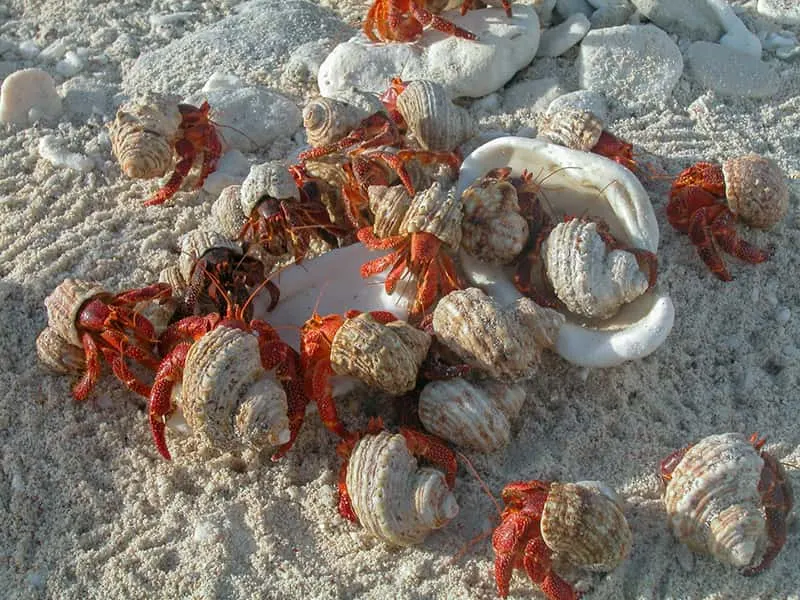
Shells
A hermit crab’s first shell is typically a sea snail shell. Hermit crabs will discard and search for new empty shells several times during their lifespan. As a hermit crab grows, it outgrows the exoskeleton and shell. When a hermit crab outgrows its exoskeleton, it must shed it. Molting is the process of shedding an exoskeleton. A marine hermit crab buries itself in the sand while it’s molting. The molting process takes about two months. The hermit crab grows new skin that will become an exoskeleton.
An aquatic hermit crab begins its search for a new shell after it has finished molting. A hermit crab uses its sense of smell to find an empty shell. These crabs detect the smell of molecules that are in the spit of predators that eat shelled creatures. When the hermit crab detects these molecules, it uses its antennae and smell to locate the shell of the creature that was eaten.
Marine hermit crabs have another method of finding a suitable shell. This method is referred to as a “vacancy chain.” The “vacancy chain” begins when a hermit crab finds a shell that is too large for it to use. He remains in the area where he discovered the too-large shell. He waits for another hermit crab to move into the too-large shell. When a creature discards its smaller shell to move into the larger one, the first hermit crab will be able to move into the smaller shell.
Diet
Marine hermit crabs are omnivores. They aren't picky eaters. They will eat both dead and live sea creatures. Aquatic hermit crabs feed on aquatic plants. They also eat small sea creatures such as tube worms and shrimp. They have been known to feed on larger marine animals such as seahorses, fish, and squid.
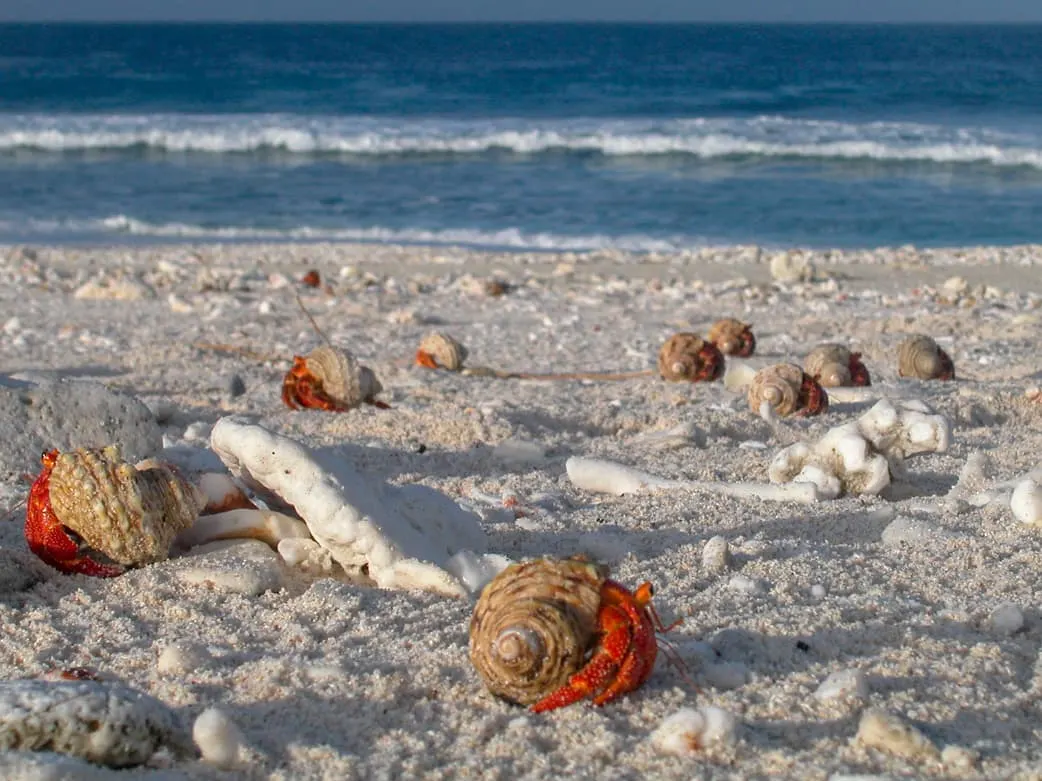
Offspring
A female marine hermit crab lays between 800 and 50,000 eggs at a time. The larger a female hermit crab is, the more eggs she lays. Baby hermit crabs pass through three stages until they change into juvenile hermit crabs.
The transformation from larva to juvenile hermit crab takes about three months. When hermit crabs first come out of their eggs, they are in their first larval stage, called zoeae. Zoeae larvae are microscopic and float on the ocean's surface alongside plankton.
After sixty days, the zoeae transform into megalopa. Megalopa look like spiders and are about the size of a thumbnail. When megalopa are thirty days old, they burrow themselves into the sand. Juvenile megalopa emerge from the sand as juvenile hermit crabs after growing and molting. The juvenile marine hermit crabs then seek out a shell and a colony of hermit crabs to join. It takes about two years for a juvenile hermit crab to mature into an adult hermit crab.
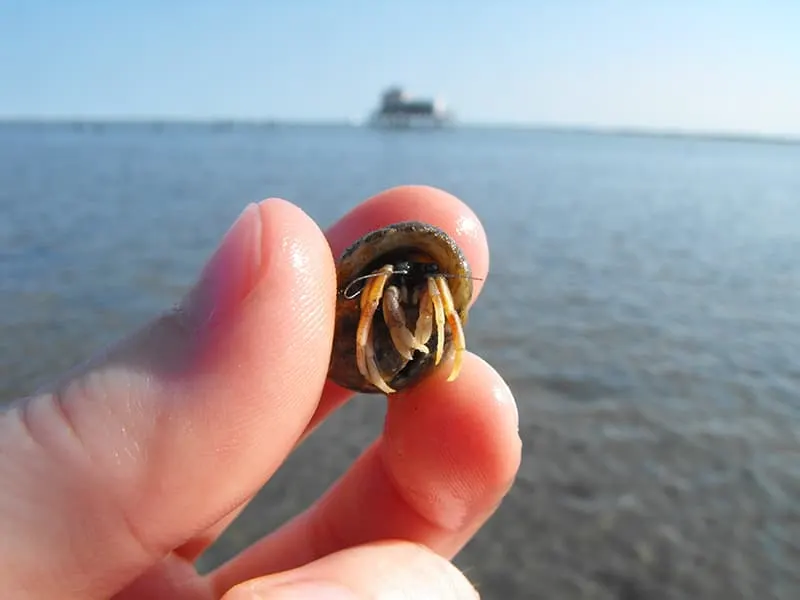
Classification/Taxonomy
Kingdom: Animalia
Phylum: Arthropoda
Subphylum: Crustacea
Class: Malacostraca
Order: Decapoda
Infraorder: Anomura
Family: Coenobitidae
Genus: Coenobita
History
Crabs and spiders descend from the same arthropod ancestor. Hermit crabs evolved from “free-living” crabs. “Free-living” crabs are crabs that do not need to find a shell to live in. For over 150 million years, hermit crabs have lived in shells they find.
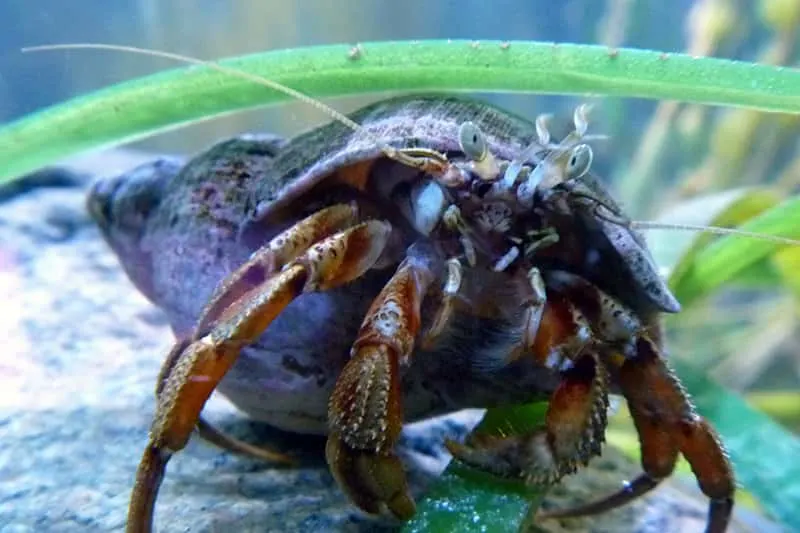
Predators
Marine hermit crabs are preyed upon by many ocean predators. Sharks, fish, blue crabs, snails, and octopus are some of the predators that prey on aquatic hermit crabs.
Lifespan
In the wild, hermit crabs can live for up to thirty years. In captivity, marine hermit crabs have a shorter lifespan. Aquatic hermit crabs live for one to twelve years in captivity.
25+ Interesting Hermit Crab Facts
- The larger a hermit crab is, the longer it takes for it to molt.
- Male hermit crabs grow faster than female hermit crabs.
- It is hard to tell the difference between a molting hermit crab and a dead one.
- Hermit crabs can grow back their limbs and claws.
- Hermit crabs consume their discarded exoskeletons.
- If attacked, hermit crabs will give up a claw to a predator.
- Hermit crabs have a more difficult time finding large shells to live in than small shells.
- Painted shells are toxic to hermit crabs.
- A hermit crab will die if it is pulled out of its shell.
- Juvenile hermit crabs molt about 5 times a month.
- Adult hermit crabs molt about once every year and a half.
- All species of hermit crabs mate in the ocean.
- Hermit crabs are not true crabs.
- Some species of marine crabs have small hairs that they use to smell and taste.
- Some marine hermit crabs have symbiotic relationships with anemones.
- If a hermit crab needs to stay small, it can do so by molting.
- Aquatic hermit crabs are more difficult to keep as pets than terrestrial hermit crabs.
- Hermit crabs can make chirping sounds.
- Hermit crabs recall important details such as what they ate and where they found shells to live in.
- We believe that aquatic hermit crabs do not kill each other for food.
- Hermit crabs only see colors of blue, yellow, and grey.
- Hermit crabs can see 360 degrees and in the dark.
- Hermit crabs cannot live in dry areas.
- Hermit crabs need to stay warm to survive.
- Mr. Krabs from the SpongeBob SquarePants cartoon is most likely a red rock crab rather than a hermit crab.
We hope you enjoyed learning all about aquatic hermit crabs! Did you learn any new facts? Let us know what other interesting things you know about them. We look forward to hearing from you!
